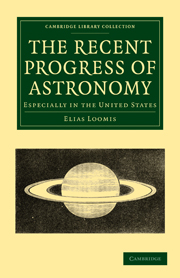Book contents
- Frontmatter
- PREFACE
- Contents
- CHAPTER I RECENT ADDITIONS TO OUR KNOWLEDGE OF THE PLANETARY SYSTEM
- CHAPTER II RECENT ADDITIONS TO OUR KNOWLEDGE OF COMETS
- SECTION I
- SECTION II
- SECTION III
- SECTION IV
- SECTION V
- SECTION VI
- SECTION VII
- CHAPTER III ADDITIONS TO OUR KNOWLEDGE OF FIXED STARS AND NEBULÆ
- CHAPTER IV PROGRESS OF ASTRONOMY IN THE UNITED STATES
- POSTSCRIPT
- Frontmatter
- PREFACE
- Contents
- CHAPTER I RECENT ADDITIONS TO OUR KNOWLEDGE OF THE PLANETARY SYSTEM
- CHAPTER II RECENT ADDITIONS TO OUR KNOWLEDGE OF COMETS
- SECTION I
- SECTION II
- SECTION III
- SECTION IV
- SECTION V
- SECTION VI
- SECTION VII
- CHAPTER III ADDITIONS TO OUR KNOWLEDGE OF FIXED STARS AND NEBULÆ
- CHAPTER IV PROGRESS OF ASTRONOMY IN THE UNITED STATES
- POSTSCRIPT
Summary
This comet was discovered on the 1st of October, 1847, by Miss Maria Mitchell, of Nantucket. As a relaxation from the severer toil of a systematic course of observations, she had employed the intervals through the preceding year in sweeping for comets; but her labors had hitherto been only rewarded by a familiarity with comet-resembling nebulæ, which she had constantly and carefully recorded. The instrument employed on these occasions was a forty-six inch refractor, with an aperture of three inches, mounted on a tripod, and furnished with a terrestrial eye-piece of moderate power. On the evening of October 1st, a circular nebulous body appeared in the field of the telescope, a few degrees above Polaris. There was scarcely a doubt of the cometary character of this object, inasmuch as the region which it occupied had frequently been examined. Still, as the object was faint, and the weather uncommonly clear, a possibility existed that this too was a nebula not before observed. On the evening of the 2d, its change of place was manifest. No appearance of condensation of light toward its center, nor any indication of a train, could be detected. It is evident that its apparition, even to the telescope, was sudden. Its first apparent motion was inconsiderable, and the region of its discovery had been constantly swept over by the assistant observer at Cambridge, with his excellent comet-seeker, even as late as the previous evening. This idea is strengthened by the subsequent rapid increase of the brilliancy of the comet, and the acceleration of its apparent motion.
- Type
- Chapter
- Information
- The Recent Progress of AstronomyEspecially in the United States, pp. 150 - 152Publisher: Cambridge University PressPrint publication year: 2010First published in: 1856

